PROTECT YOUR DNA WITH QUANTUM TECHNOLOGY
Orgo-Life the new way to the future Advertising by AdpathwayAs the loud, melodic songs of migratory warblers and tanagers disappear, and the frantic activity around breeding territories ceases. In the vacuum left by the departing summer residents, two groups of small, resourceful birds, the Chickadees and the Nuthatches, step forward to take center stage.
For these year-round residents, October is the most critical time of the year, marking the moment they form winter flocks and establish the precise, defensible territory they must rely on for sustenance and safety during the brutal cold months ahead. By understanding the unique foraging, caching, and social behaviors of chickadees and nuthatches, you can appreciate why your yard becomes their high-priority operational center right now, and how you can become an indispensable partner in their survival.
The Social Strategy of the Chickadee
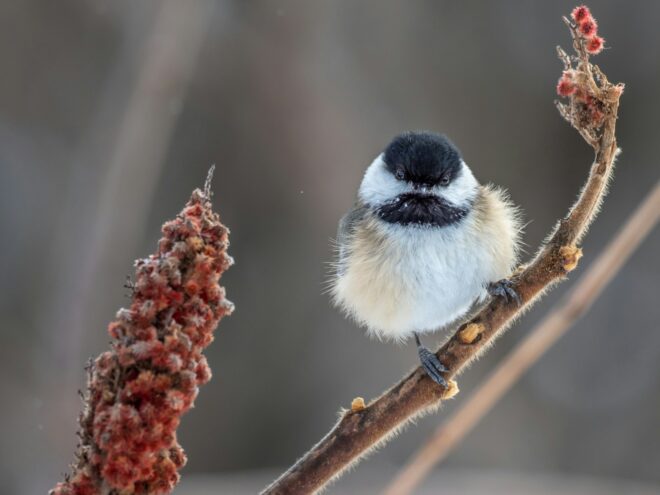 Photo by Patrice Bouchard
Photo by Patrice BouchardIn the U.S., the most common species—the Black-capped Chickadee (north) and the Carolina Chickadee (south) – are tiny dynamos whose survival hinges on sophisticated social organization.
The Dissolution and Re-Formation of Flocks
During the spring and summer, chickadees are strictly territorial, defending small breeding plots as mated pairs. But by October, this dynamic completely changes. The single-pair territories dissolve, and birds begin to organize into non-breeding, winter foraging flocks.
These flocks are the cornerstone of their winter survival strategy. They typically consist of 4 to 12 individuals and are highly stratified.
The Pecking Order
Each flock develops a strict, linear dominance hierarchy. High-ranking birds get first access to high-value food (like your feeder), while lower-ranking members must wait their turn. This hierarchy is established and reinforced through constant vocal and physical interactions—the very scolding, chirping, and sparring you hear in October. The high frequency of these calls serves to maintain flock cohesion and continuously test the dominance structure.
The Advantage of Safety in Numbers
The primary benefit of the flock is predator defense. As leaves drop, visibility for raptors like the Sharp-shinned Hawk and the Cooper’s Hawk increases dramatically. The flock provides multiple sets of eyes to spot a threat. The moment one bird sounds the alarm—the famous, often rapidly repeated “chick-a-dee-dee-dee” call – the entire group reacts instantly, disappearing into dense cover. The more “dee” notes, the higher the perceived threat.
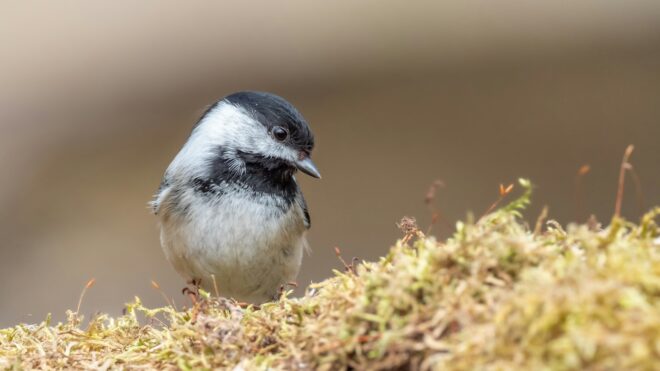 Photo by Patrice Bouchard
Photo by Patrice BouchardThe Crucial October Caching Frenzy
The reason chickadees are so active and persistent in your yard in October is their phenomenal need to hoard calories. Chickadees rely heavily on a strategy called scatter hoarding to survive winter nights, where they lose up to 10% of their body weight just to maintain temperature. They must find, transport, and hide enough food daily to offset this loss.
A single chickadee can cache hundreds of seeds in one afternoon. They hide these seeds (mostly Black Oil Sunflower Seeds and sunflower hearts) in thousands of individual spots: under lichens, in tree bark crevices, behind pine needle clusters, or in cracks in wood fences. Incredibly, they remember the exact location of these caches, thanks to a specific brain region (the hippocampus) that enlarges in the autumn to handle the massive spatial memory requirement.
Your feeder is the ultimate, non-stop grocery store for this operation. A chickadee will fly to your feeder, quickly grab one seed, and immediately fly to a nearby tree to cache it. The louder and more frequent their calls, the more serious and successful their caching operation is. In October, you are witnessing the critical phase where they fill their “winter pantry.”
The Nuthatch’s Independent Tenacity
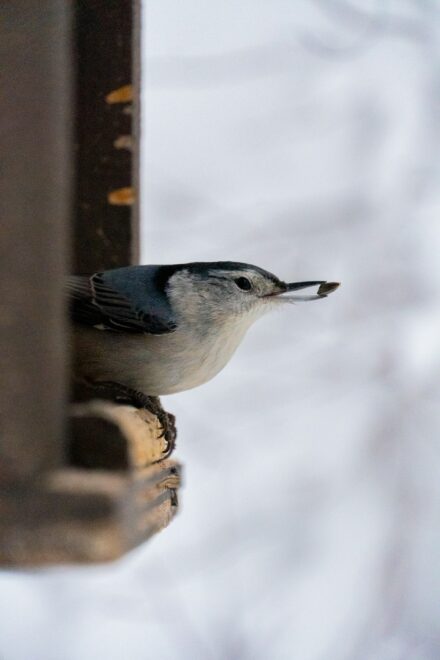 Photo by Alex Ranney
Photo by Alex RanneyNuthatches (the White-breasted and Red-breasted varieties being most common across the U.S.) also become more conspicuous in October, but their strategy is fundamentally different from the chickadee’s social model.
Solitary Defense of a Mega-Territory
Nuthatches typically remain in pairs year-round or forage alone, unlike chickadees. Their October activity is less about flock coordination and more about establishing and defending a much larger, solitary territory required to sustain them through the winter. Nuthatches are known as the only bird species that habitually moves headfirst down a tree trunk. This unique gait gives them a competitive advantage, as they can spot insects and hidden seeds missed by birds foraging upward.
Their signature vocalization is a loud, nasal “yank-yank-yank!” call. In October, this call becomes a frequent, persistent sound used primarily for territorial defense. This loud sound communicates to other nearby nuthatches that this area—which includes not just the trees but the valuable feeder as well—is occupied. It is a solo bird’s way of projecting authority over a wide area.
The Red-breasted Nuthatch and Caching
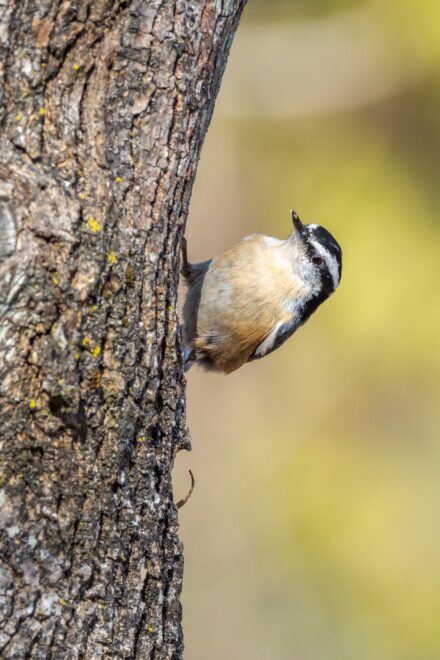 Photo by Patrice Bouchard
Photo by Patrice BouchardWhile all nuthatches feed heavily in preparation for winter, the smaller, more northerly Red-breasted Nuthatch exhibits a caching behavior closer to the chickadee, though with a distinct technique. They are famous for their relationship with conifer seeds (pine, spruce, hemlock). They will take sunflower hearts or peanuts from a feeder and jam them into bark crevices, often using a small piece of lichen or bark to “pitch” the seed over, sealing the cache from rivals.
They also expertly wedge seeds into the gaps of pine cones to retrieve later. The October rush sees them aggressively pushing out rivals at feeders to secure these high-fat, high-value seeds for storage.
The Symbiotic Relationship
While chickadees and nuthatches have different social structures, their October strategies converge in the backyard, creating the common mixed-species flock so beloved by birders.
The Mixed-Species Flock Advantage
In the autumn and winter, chickadees and nuthatches often travel together, along with Downy Woodpeckers, Titmice, and Creepers, in mixed-species flocks. The chickadee flock is usually the nucleus of this group. Their incessant chatter and their detailed spatial knowledge of food caches and safe refuge points guide the movement of the entire flock. Nuthatches, with their wider territories and unique headfirst foraging view, serve as excellent, if independent, lookouts. They often spot predators from angles that chickadees miss.
By foraging together, the birds benefit from having less ground to cover individually, while the combined noise and activity level helps to maintain a defensive perimeter against raptors.
The Birder’s Critical Role
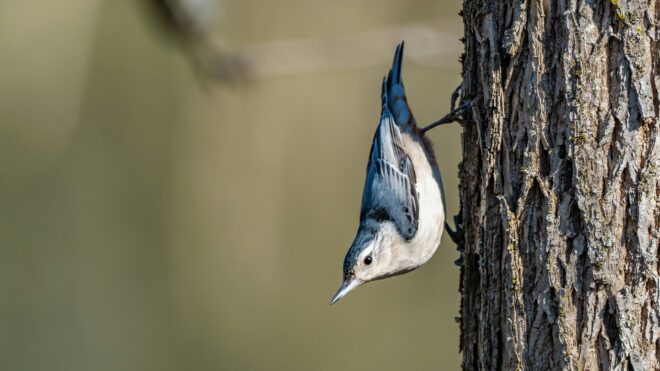 Photo by Patrice Bouchard
Photo by Patrice BouchardThe intense, high-stakes planning and hoarding conducted by chickadees and nuthatches in October underscore the immense value of a well-maintained feeding station. Your consistency during this time is not a luxury for them; it is a key variable in their survival equation. Focusing on Black Oil Sunflower Seeds (in shell) and hulled sunflower hearts provides the optimal energy-to-effort ratio for caching. Offering high-quality suet (no-melt) supplies immediate, dense fat.
Since chickadees and nuthatches have strict dominance hierarchies, placing multiple feeders around the yard reduces congestion and conflict, allowing low-ranking birds to access food without constantly being chased away by dominant individuals.
A reliable source of clean, unfrozen water (a heated bird bath is ideal) is also essential. Birds need water for drinking and for preening their feathers – the only insulation they have against the long, cold winter nights.
Final Thoughts
The increased clamor from chickadees and the insistent yank-yank of nuthatches in October is the sound of survival preparation. They are literally mapping, stocking, and defending their winter world. Their heightened presence marks your backyard as an integral and indispensable element in their strategy to beat the cold, making the autumn season one of the most important and rewarding times to be a dedicated U.S. birder.




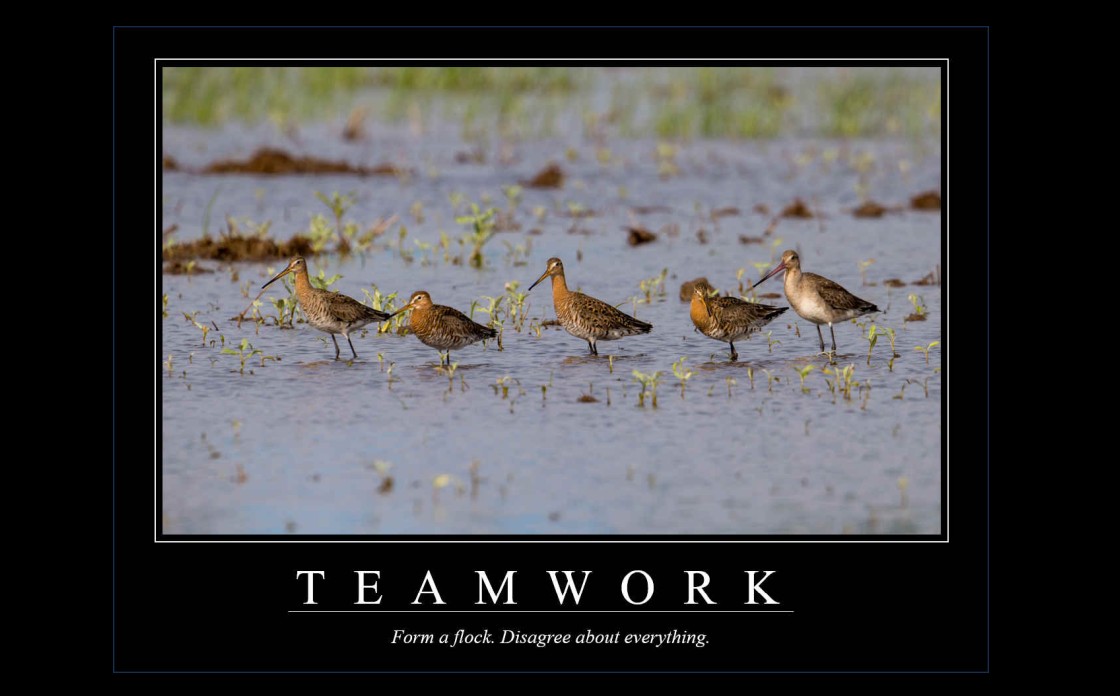


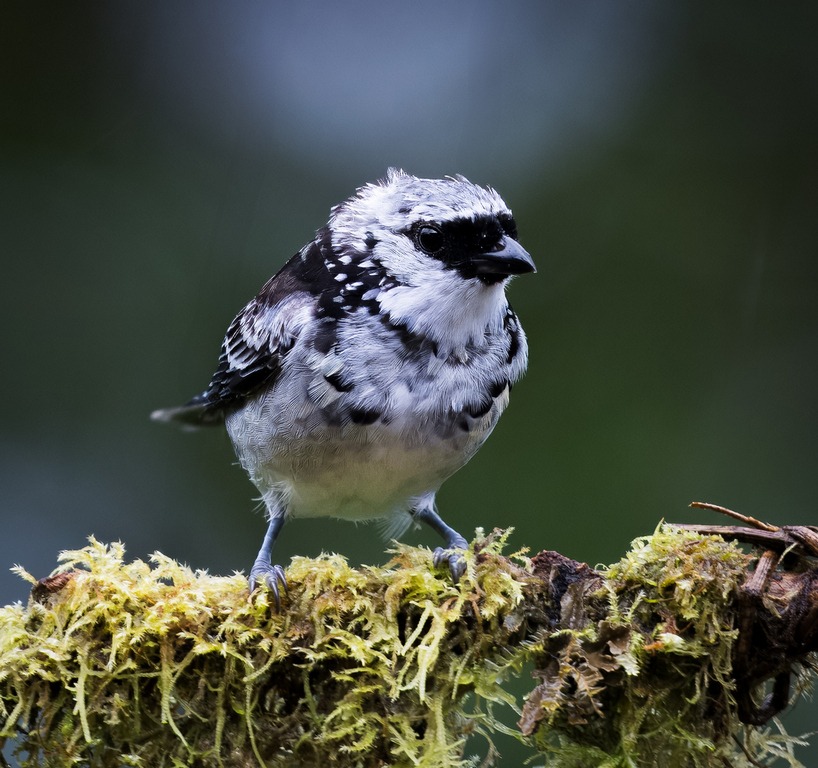















 English (US) ·
English (US) ·  French (CA) ·
French (CA) ·